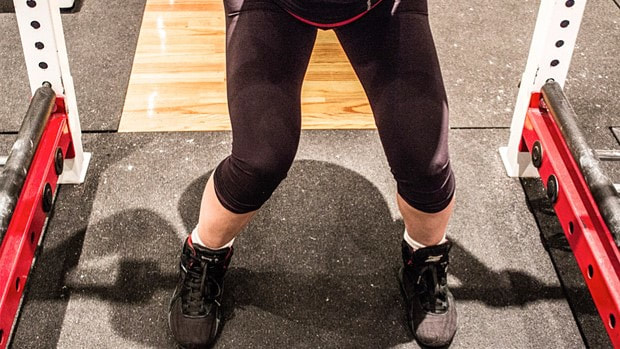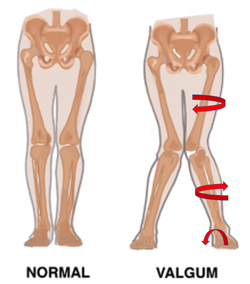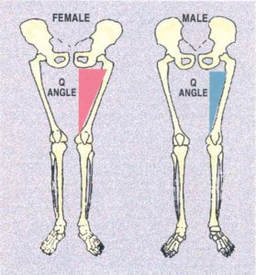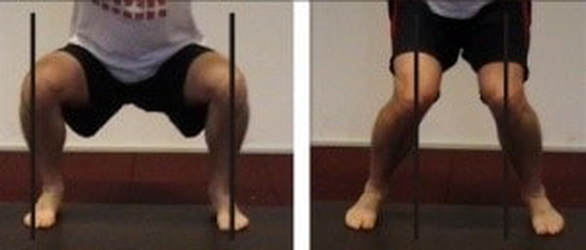Have you ever seen someone squat in the gym with their knees about to touch? What about that time you were running behind someone and watched their knees give in whenever their foot hit the ground? A voice deep inside of you says that doesn’t look right. Their knee is basically caving in. Then, you are at the gym one day and record yourself squatting or watch yourself squat in the mirror, and then suddenly you realize YOUR knees cave in too! Is this normal??

The short answer is no – as this movement pattern has been highly correlated with an increase in both traumatic (ex: ACL tear) and non-traumatic (ex: patellar tendinosis) injuries. However, this movement pattern is so common, some might consider it normal. Let’s first talk about what’s going on here. Firstly, this movement pattern is known as dynamic knee valgus, also referred to as valgus collapse or knee caving. The knee joint functions generally as a hinge joint; however, it also rotates subtly both in internal and external rotation as we flex and extend out leg. This mild rotation cannot be overlooked. If we develop excessive amounts of rotation in either direction, shear forces increase, and pain can result.

Knee valgus occurs when we combo this excessive rotation with hip adduction and often opposite side pelvis/hip drop. Now, many athletes will display this movement pattern without pain – this relates directly to their tissue tolerance. These athletes haven’t created enough shear yet to reach the pain threshold, and often they can get away with it, sometimes for a long period of time. However, if left untreated, it can lead to patella-femoral pain syndrome, IT band syndrome, patellar tendinosis, hamstring tendinopathy, meniscal tears, ligamentous injuries and a host of other issues up and down the chain.
So what causes excessive rotation at the knee?
For starters, women are more likely than men to display this movement pattern during activity, much of which is related to their anatomy (wider hips and “Q” angle – see below). It’s also commonly seen in sports or activities that require ‘toeing out’ such as with ballet dancers, soccer, basketball, and ice skaters. Some people may have structural factors such as natural bone structure in their hips, knees, and ankles which may predispose them to have more knee valgus than others. However, the knee valgus we refer to the most is dynamic knee valgus which occurs during movement, and often due to a variety of modifiable risk factors. It’s often correlated with squatting, jumping, running, lunging, but can be present anytime we bend our knee while weight bearing.

Here are the top reasons dynamic valgus can occur:
- Poor motor control: This typically occurs in novice athletes or those without much movement training. They lack neuromuscular control of the trunk, hip, knee, and ankle, and are often labeled as “motor morons” (no offense haha)
- Muscle imbalances: This primarily includes overly dominant hip internal rotators (TFL, anterior glute med, medial hamstrings) and adductors, and weak hip external rotators (posterior glute med, glute max)
- Mobility restrictions: Relating to stiff hips, ankles, or thoracic spine
- Poor arch stability: Relating to excessive pronation or “flat feet”
Knee valgus could initiate from a combination of these factors, but once it “sets-in,” it becomes a brain/nerve problem (muscle memory) and not just a strength or flexibility problem. Therefore, you’ll always have to re-groove squat patterns even after restoring impairments or imbalances.

If your dealing with this movement pattern, you need to put in effort to correct it. Understand that just because you may not have pain at the moment, it doesn’t mean that its normal. Making efforts to keep your knees in relative alignment with your hips and ankles when your workout can go a long way. First see if you can correct the movement pattern by simply paying more attention to your technique. If it still feels very difficult, it may be related to your mobility (hips and/or ankles) or your strength balance (glute max and glute med primarily). Check out our YouTube channel for great hip and ankle mobility exercises. For strengthening; exercises like deadlifts, lunges, step ups, side steps, or KB swings – all of which target the glutes – are great options. If you’re dealing with knee pain and want the fast track back to 100%, we can get you there. E-mail [email protected] or click the button below to get started!
Thanks for reading,
Jesse Xiong
Edited by Dr. Andrew

